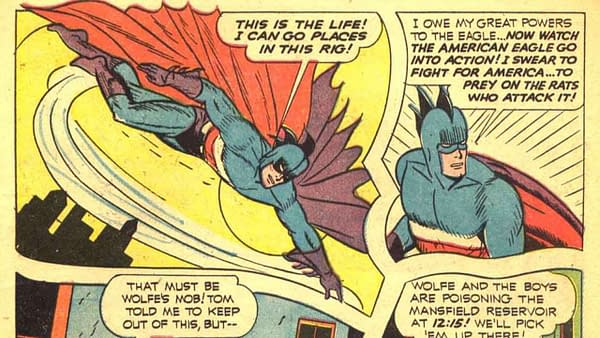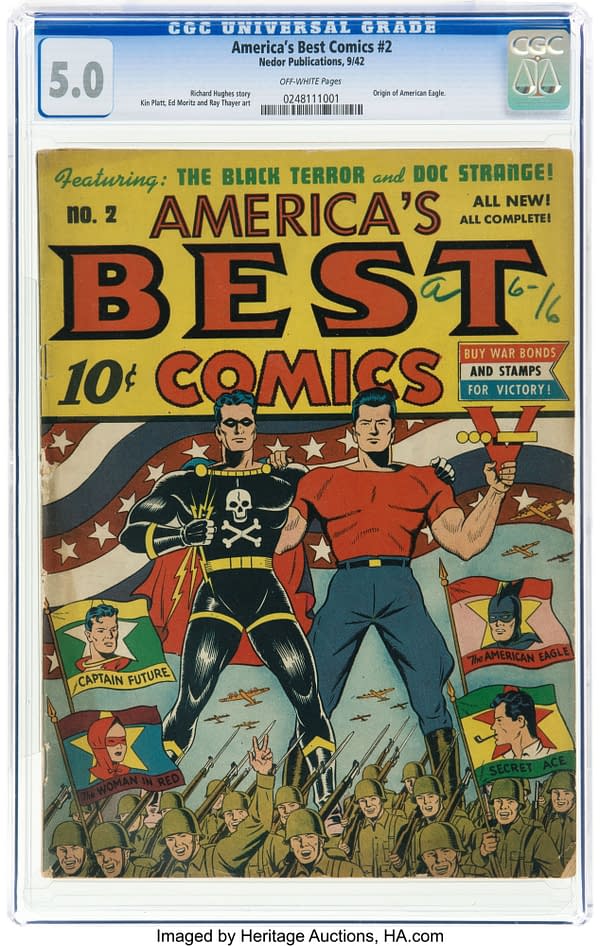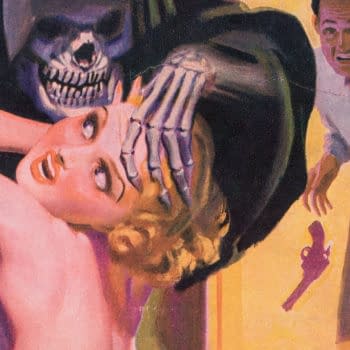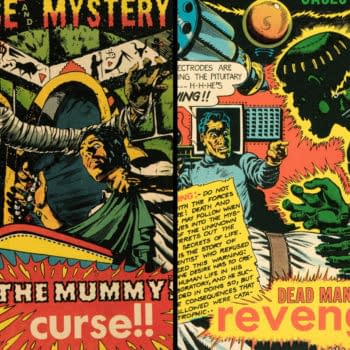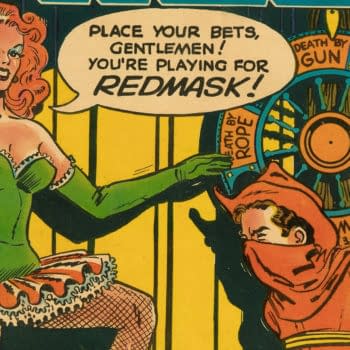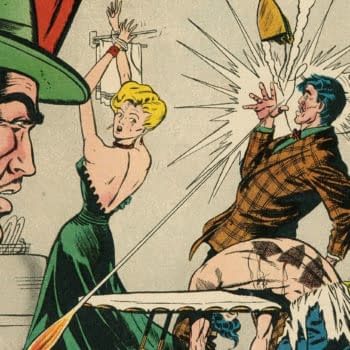The Debut of American Eagle in America's Best Comics #2, at Auction (original) (raw)
Posted in: Comics, Heritage Sponsored, Vintage Paper | Tagged: golden age, Ned Pines, Standard/Better/Nedor
It was hard to be unique in the WWII patriotic hero market, but American Eagle's origin gave him "the strength and bouyances of an eagle."
Published Wed, 22 Feb 2023 08:05:09 -0600
|
Last updated Wed, 18 Sep 2024 09:30:22 -0500
|
Article Summary
- American Eagle debuted in America's Best Comics #2, 1942.
- Possessing an eagle's strength and buoyancy, scientist Tom Standish turns into the unique superhero American Eagle.
- Created by Richard E. Hughes and Kin Platt, the character appeared in America's Best Comics and Exciting Comics.
- America's Best Comics #2 is a rare, underappreciated issue with only 23 entries on the CGC census.
While entering a field that had already become competitive with patriotic superheroes by 1942, American Eagle still managed to be unique — in powers and appearance, if not in name. As explained in his origin and first appearance in America's Best Comics #2, his powers came from being "accidentally endowed with the strength and buoyancy of an eagle." Publisher Standard/Better/Nedor must have thought they had something interesting on their hands, as the character would immediately start getting cover appearances in Exciting Comics after his America's Best Comics debut. An unusual reflection of this moment in history,
America's Best Comics #2 (Nedor Publications, 1942) featuring the debut of American Eagle
American Eagle was created by Richard E. Hughes and Kin Platt, and was the latest in a long line of patriotic superheroes that had emerged since 1940, when MLJ's the Shield had debuted. While MLJ's the Shield was ahead of the curve with his January 1940 cover-dated debut, 1941 unleashed a veritable army of patriotic American heroes, including Captain America, Fighting Yank, and U.S. Jones Super-American, the Flag and quite a few others. And notably, Fox had already debuted their own patriotic character more simply named "The Eagle" as well. But Standard/Better/Nedor's American Eagle was scientist Tom Standish, assisting another man named Dr. Wolf in the creation of a serum that can impart an eagle's "strength and bouancy." Standish accidentally spills a serum vial on a cathode-ray tube, and decides to try it in a projector. This results in a weird black ray striking him from the projector. Soon, Standish realizes that Dr. Wolf is a Nazi who intends to poison America's water supplies. He subsequently realizes he has great strength and the ability to sort of leap or float great distances into the air. A caped costume completes his transition by enabling him to fly. The character would make numerous appearances in both America's Best Comics and Exciting Comics.
Versatile writer/artist Kin Platt was the initial artist of Startling Comics' Captain Future and may have also been the writer and creator of this version of the character. Platt was also the creator of Supermouse for Standard's Coo Coo Comics, and that character would become the longest-running feature of the Pines comic book empire. Platt contributed work to various publishers during the Golden Age, including Marvel/Timely, Standard/Better/Nedor, Fawcett Publications, and MLJ. He took over the long-running Mr. and Mrs. newspaper comic strip 1947-1963. Platt did extensive writing work for TV animation during the 1960s, including for The Jetsons, The Flintstones, and Jonny Quest. The 1961 novel The Blue Man may be Platt's best-known work of science fiction.
There are only 23 entries for America's Best Comics #2 on the CGC census, indicating that this a pretty tough get even by the standards of the 1942 era. An underappreciated Ned Pines offering with a stand-out cover,
America's Best Comics #2 (Nedor Publications, 1942)

Affiliates of Bleeding Cool buy from and/or consign to Heritage Auctions.
Enjoyed this? Please share on social media!
![]() Stay up-to-date and support the site by following Bleeding Cool on Google News today!
Stay up-to-date and support the site by following Bleeding Cool on Google News today!
About Mark Seifert
Co-founder and Creative director of Bleeding Cool parent company Avatar Press since 1996. Bleeding Cool Managing Editor, tech and data wrangler, and has been with Bleeding Cool since its 2009 beginnings. Wrote extensively about the comic book industry for Wizard Magazine 1992-1996. At Avatar Press, has helped publish works by Alan Moore, George R.R. Martin, Garth Ennis, and others. Vintage paper collector, advisor to the Overstreet Price Guide Update 1991-1995.
Latest by Mark Seifert
Shudder Pulp Decade: The Emotional Effect Produced by Extreme Fear
Weird Menace: The 1930s rise of the Shudder Pulps followed by the rise of the forces that ended them and transformed horror on the newsstand.
The Pre-Code Horror of L.B. Cole's Star Publications Era, at Auction
L.B. Cole produced a number of stand-out Pre-Code Horror covers during his Star Publications era.
Steve Ditko Horror and Dr. Death, This Magazine is Haunted, at Auction
This Magazine is Haunted #16 (Charlton, 1954) features the second-ever Steve Ditko cover, and the highest-graded copy is up for auction. #Ditko #sponsored
Matt Baker & More, the Pre-Code Horror of Strange Mysteries at Auction
Superior Comics' 1951-1955 Pre-Code Horror title Strange Mysteries featured stand-out art from Iger Studio, including Matt Baker.
Zodiac and the Tim Holt #30 Death Wheel Connection, up for Auction
The "Death Wheel" in 1952's Tim Holt #30 cover by Frank Bolle has long been a matter of interest to people who research the Zodiac killer.
Hillman Commits to Crime in Clue Comics, at Auction
Hillman hired Crime Does Not Pay creators Charles Biro and Bob Wood to launch Clue Comics for them, but it seems not to have worked as planned.
